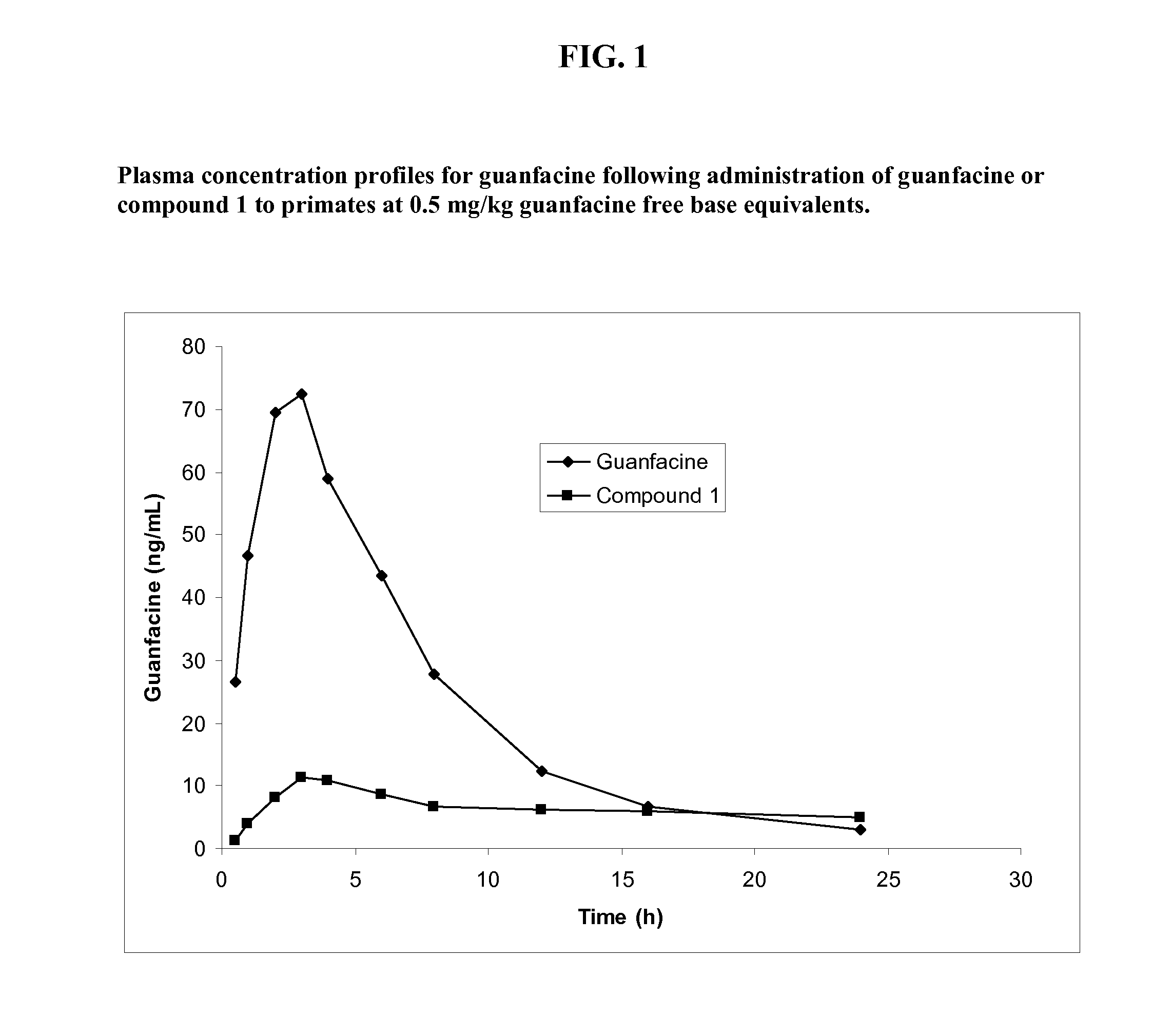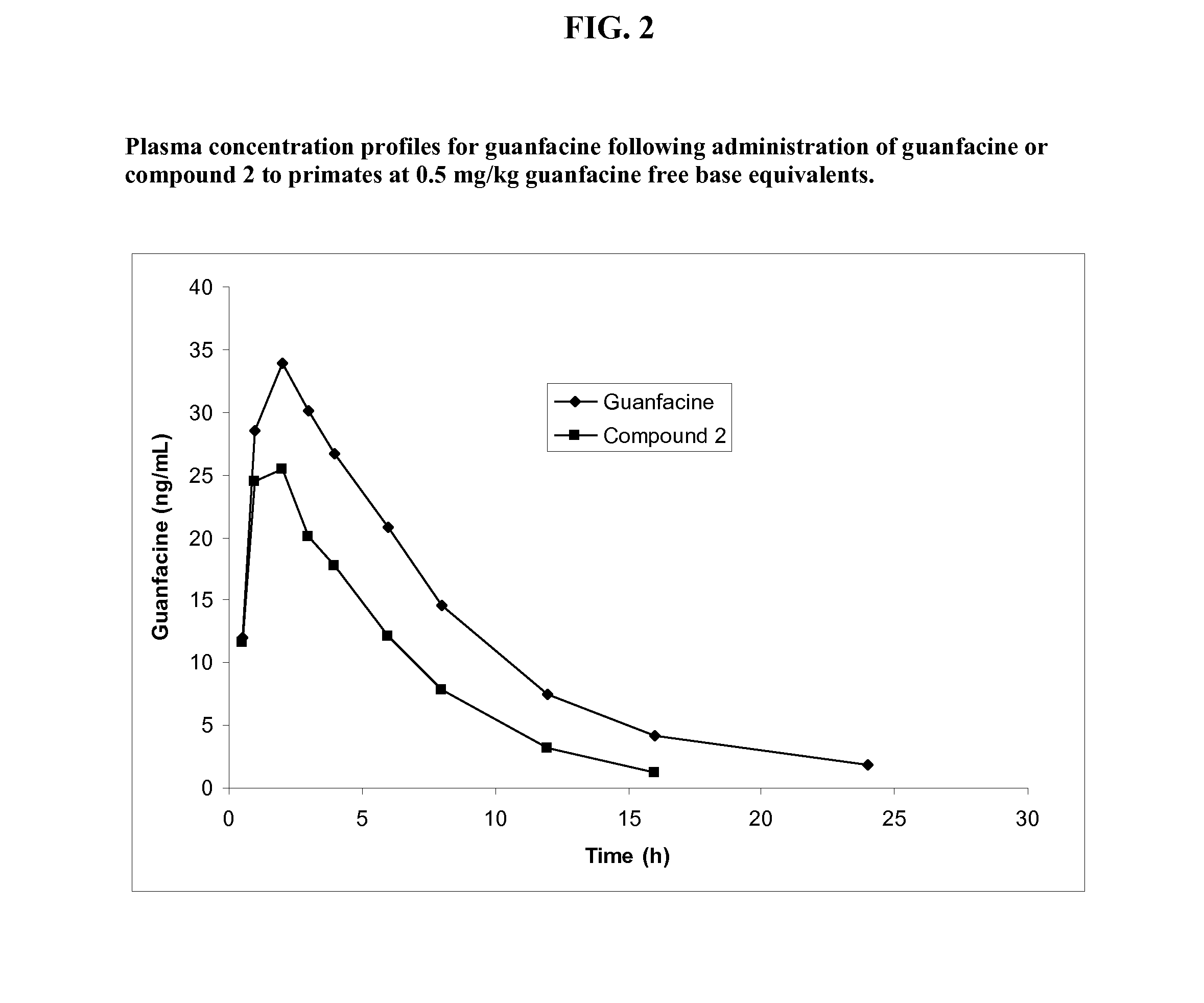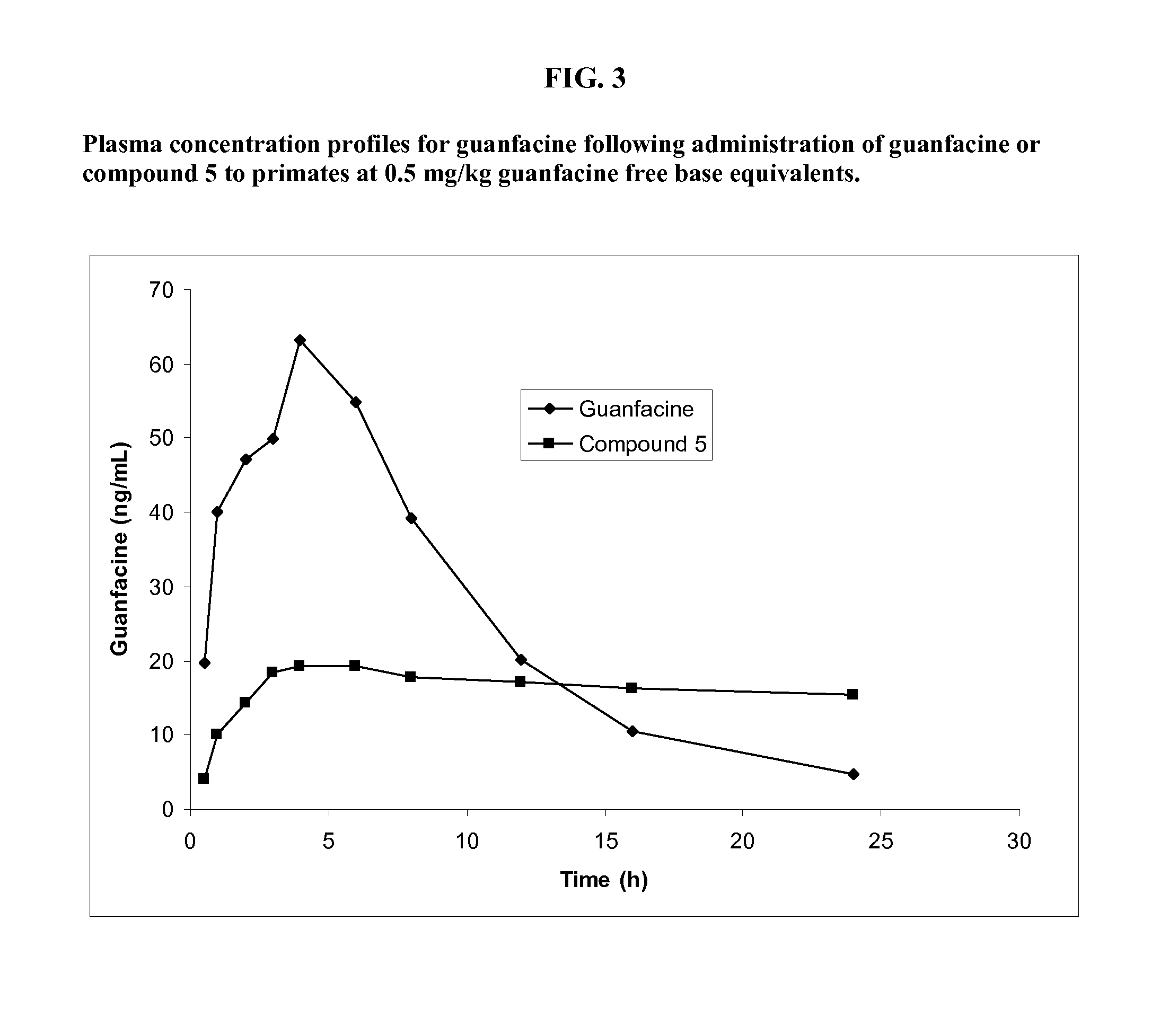Prodrugs of guanfacine
a technology of guanfacine and guanfacine, which is applied in the direction of drug compositions, amide active ingredients, cardiovascular disorders, etc., can solve the problems of 30% of patients who do not respond to can not tolerate long-term therapy with guanfacine, and can not improve prefrontal cortical deficits, so as to prolong the duration of action and improve the pharmacokinetics
- Summary
- Abstract
- Description
- Claims
- Application Information
AI Technical Summary
Benefits of technology
Problems solved by technology
Method used
Image
Examples
example 1
Preparation of Guanfacine-Glutaryl-Valine Amide (Compound 1)
[0238]The synthesis of guanfacine-[glutaryl-(S)-valine] amide trifluoroacetate was accomplished in four steps. Glutaryl-(S)-valine tert-butyl ester was obtained through the reaction of (S)-valine tent-butyl ester with glutaric anhydride. An ‘activated ester’ was prepared from glutaryl-(S)-valine tert-butyl ester by DCC coupling with N-hydroxysuccinimide. The ester was then reacted with guanfacine to give guanfacine-[glutaryl-(S)-valine] amide tert-butyl ester. Removal of the tert-butyl group was achieved by treatment with trifluoroacetic acid to give guanfacine-[glutaryl-(S)-valine] amide trifluoroacetate. The synthetic route is shown in Scheme 1 below.
LCMS: m / z=457.00 Consistent for deprotonated ion (M−H)−
1H NMR (DMSO-d6): 9.72 (br s, 3H, 3×NH), 8.00 (d, J=8.5 Hz, 1H, NH), 7.51 (d, J=7.8 Hz, 2H, 2×ArH), 7.35 (t, J=8.0 Hz, 1H, ArH), 4.15 (m, 1H, α-CH), 4.08 (s, 2H, ArCH2), 2.45 (m, 2H, CH2), 2.22 (m, 2H, CH2), 2.02 (m, 1H, ...
example 2
Synthesis of Guanfacine-β-Alanine-Valine Amide (Compound 2)
[0239]The synthesis of guanfacine-β-alanine-(S)-valine amide di-trifluoroacetate was accomplished in six steps. N-Boc-(S)-valine was treated with DCC and N-hydroxysuccinimide to give a first ‘activated ester’ which was then coupled with β-alanine benzyl ester. Subsequent debenzylation afforded N-Boc-(S)-valine-β-alanine and this was then converted to a second ‘activated ester’ by DCC coupling with N-hydroxysuccinimide. This activated ester was coupled with guanfacine to give N-Boc-(S)-valine-β-alanine-guanfacine. Removal of the Boc protecting group was achieved by treatment with trifluoroacetic acid to give guanfacine-β-alanine-(S)-valine amide di-trifluoroacetate. The synthetic route is shown below in Scheme 2.
LCMS: m / z=414.00, consistent for deprotonated ion (M−H)−
1H NMR (DMSO-d6): 9.67 (br, 2H, NH2), 8.52 (m, 1H, NH), 8.10 (br, 3H, NH3+), 7.51 (d, J=8.0 Hz, 2H, 2×ArH), 7.37 (m, 1H, ArH), 4.07 (s, 2H, ArCH2), 3.51 (m, 2H, ...
example 3
Preparation of Guanfacine-γ-Glutamyl-(R)-Valine Amide (Compound 5)
[0240]The synthesis of guanfacine-γ-(S)-glutamic acid-(R)-valine amide di-trifluoroacetate was accomplished by a procedure involving six reaction steps. N-Boc-(R)-valine was first treated with DCC and N-hydroxysuccinimide to give a first ‘activated ester’. This ‘activated ester’ was then coupled with H-Glu(OBn)-OtBu and subsequent debenzylation afforded N-Boc-(R)-valine-(S)-glutamic acid tert-butyl ester.
[0241]This was converted to a second ‘activated ester’ by DCC coupling with N-hydroxysuccinimide and the ester was reacted with guanfacine to give N-Boc-(R)-valine-(S)-glutamic acid (guanfacine) tert-butyl ester. Removal of the tert-butyl ester and Boc groups was successfully achieved using trifluoroacetic acid to give guanfacine-γ-(S)-glutamic acid-(R)-valine amide di-trifluoroacetate. The synthetic route is shown in Scheme 3.
LCMS: m / z=473.96, consistent for protonated ion (MH)+
NMR (DMSO-d6): 9.53 (br, 2H, NH2+), 8.7...
PUM
| Property | Measurement | Unit |
|---|---|---|
| temperature | aaaaa | aaaaa |
| pH | aaaaa | aaaaa |
| deficit hyperactivity disorder | aaaaa | aaaaa |
Abstract
Description
Claims
Application Information
 Login to View More
Login to View More - R&D
- Intellectual Property
- Life Sciences
- Materials
- Tech Scout
- Unparalleled Data Quality
- Higher Quality Content
- 60% Fewer Hallucinations
Browse by: Latest US Patents, China's latest patents, Technical Efficacy Thesaurus, Application Domain, Technology Topic, Popular Technical Reports.
© 2025 PatSnap. All rights reserved.Legal|Privacy policy|Modern Slavery Act Transparency Statement|Sitemap|About US| Contact US: help@patsnap.com



